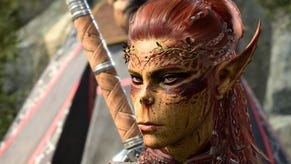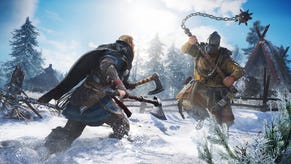Assassin's Creed Valhalla: Wrath of the Druids review
Púca boo.
I'll get this out the way first. I understand there are people who may not want more Assassin's Creed Valhalla. It is an enormous game and, for sure, Wrath of the Druids is no minor DLC. To those people, I hear ya, and thank you for your time here today! Lovely. To those who are hungry for more Eivor and to hang out in a new country's history, welcome. Ireland offers lots of familiar things to do across a beautiful new landscape, and some fun fresh additions.
Here's the top-line stuff. Wrath of the Druids adds around two-thirds of Ireland to explore, with an enjoyable self-contained campaign, some interesting new enemies, a major new trading system and, fans will be pleased to know, a boatload of fresh armour sets and cosmetics to unlock and upgrade. This is an adventure focused on Eivor - and while things do skirt very slightly into the supernatural, there's no major modern day or Isu plotline here.
Designed to be played at any point of your Viking adventure, Druids introduces a new cast of characters led by your hitherto unmentioned cousin Barid, who has wound up becoming King of Dublin (where was he when we were trying to sort out England, eh?). Barid calls for aid via his trade envoy, the intriguing one-eyed Azar, who turns up in Ravensthorpe to rope Eivor in. From there, the action heads across the Irish Sea to a fresh map accessible via your Atlas, akin to Vinland and Norway, and the start of a sprawling new adventure.
If you're up on your Irish history (I admit, it was never taught at my English school), then perhaps some of what follows may ring some bells. For me, Druids was an introduction to High King Flann Sinna and his shaky relationship with the settled Norse, the rivalry between northern and southern Irish kingdoms, and the Children of Danu: a death cult capable of summoning up representations of werewolves through brain-fuddling fog (this is standard Irish history 101, right?).

If you've spent a bit of time with Valhalla's main story (or north of 100 hours exploring further, hi there!), you'll quickly find yourself at home here in another tale of kings, castles and political scheming, along with the Ubisoft's own unique definition of stabbing lots of people to achieve a tenuous peace. Likewise, then, you'll be familiar with Eivor's role - a one woman wrecking crew, attempted infiltration expert and flirt. Over the course of around 15 hours, and over the size of a couple of Valhalla's original map regions, you'll get to flex all of those muscles once again. Nearly every activity from the main game is also available here, including new legendary monsters, lost Vikings warriors, and offbeat side stories. Even better, I've explored pretty much all of the Ireland map now and not found any more sodding rock cairns. [Edit: I spoke too soon. Shit.]
Valhalla's version of England is up there as one of the best open worlds crafted for any Assassin's Creed - and on new consoles it is certainly the most beautiful. Ireland continues this same level of quality with towering rock cliffs and lush green slopes, enormous waterfalls and quiet wooded glens. Sometimes, showers of rain will leave fleeting rainbows behind. Away from the main questline, it's easy to get lost in the exploration of this land, its secret grottoes with hidden treasures, or simple, sad notes left behind by those who have passed by previously. Ireland is yet another accomplished creation to poke around and explore, with the crest of every hill offering you new things on the horizon to investigate.

Druids' major addition is its trade system, which hooks into a network of ring forts you'll capture and turn into upgradable, resource-building nodes. There's a gameplay loop where you'll discover a ring fort, clear it of enemies, then somewhat bizarrely hunt for its deed to officialise your trade and recruit a community of workers. From there, you can upgrade each fort further to improve output and store more goods. Each fort then sends their goods to Dublin, where you can flog them on to foreign cities. (Dublin acts as a sort of hub for this expansion, though mainly for the more mechanical bits and pieces you'll do to earn rewards. As far as its story goes, this is back to the classic Assassin's Creed linear journey round the countryside, unfogging more map as you progress.)
Your trade resources accrue over time, encouraging you to loop back to Dublin every hour of gameplay or so to empty your reserves and exchange them for exotic rewards. Eventually, you'll have a trade empire capable of shipping armour sets from various previous Assassin's Creed locations (handy!). So, yes, you can now kit Eivor in an Egyptian look, among many other things, or earn tattoos and trinkets from Constantinople to display in Ravensthorpe back home. Finally, the more quests you fulfil, the more you'll upgrade Dublin (this really only amounts to unlocking yet more contracts - though you'll also get more of your Azar's own backstory). Across the trading system and simply through progressing its story, Wrath of the Druids feels generous with its array of new cosmetic options: you'll get an incredible new mount, a new raven, various new horses, new hair and tattoo designs, and be able to unlock at least six more armour sets.
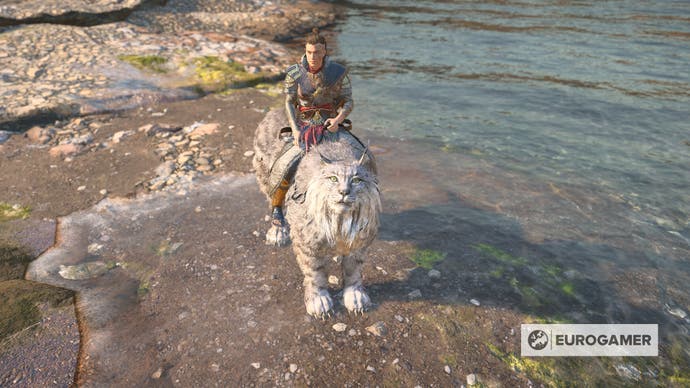
If Druids' trading system sounds similar to the mini-games featured in Assassin's Creed games of yore, here's another blast from the past: pigeon coops. These contract-bearing birdhouses are back after a long absence and offer further ways to grind out resources. It is an optional system, except when it isn't: at a couple of points in Druids' main campaign you'll be asked to pick up and complete a handful of these repeatable quests - which is a bit of a low point. These Royal Demands, meant to increase your favour with Ireland's kings, come with a bonus: Kingly Pleas, which will double your rewards if you complete additional, optional objectives. A quest might ask you to steal a king's stolen necklace (I got this several times). As a bonus, you might have to do this without killing anyone or being detected. It reminded me of the full synchronisation options for missions back in classic Assassin's Creed games - at least here, there's room for multiple autosaves.
Druids' story sags a little in the middle - there's a stretch where you're left to go hunting for Children of Danu cultists (these are druids, but bad druids, the game is keen to emphasise) where clearly the game is happy to let go of your hand for a bit. Meanwhile, its epilogue has a character development that seems a little rushed and not particularly earned. Overall, I'd slot it in somewhere in the the top half of Valhalla's main story arcs, as its extended run-time offers the benefit of being able to get closer to many of its characters. You feel for Eivor's cousin Barid as he tries to wrestle command of a land which isn't his own. You're intrigued to hear more about your trade boss Azar, who has an interesting tale to tell. And you get some lovely Irish harp playing and singing from Flann's poetess Ciara. (How much of this is accurate Irish history, though, I could not tell you.)
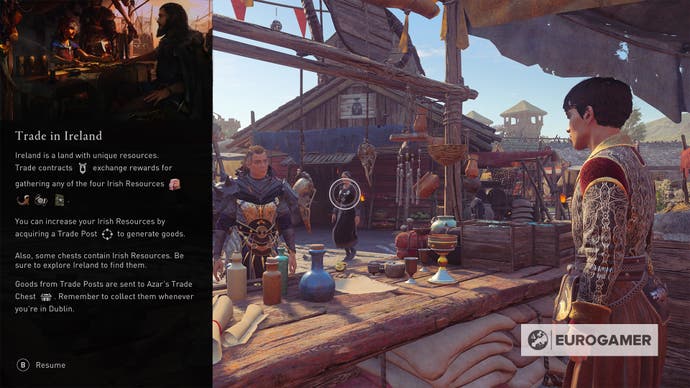
As for the Children of Danu, they are your typical shadowy Assassin's Creed group, with the fashion sense of the Blair Witch and fear gas stolen from Batman villain Scarecrow. You can fight their antler-wearing underlings in the overworld and defeat them pretty easily, but in caves and encampments where they set down hallucinogenic fog, Eivor has to fight powered up versions with unnatural powers. In-universe, this is explained away as the effects of the mushrooms and other gunk she's just huffed. In reality, this is just a cool way for you to fight some different villains and also werewolves. Technically, werewolves are initially described in-game as Púca - mystical Irish spirits which can take various animal forms - although here, that form is always werewolves.
Finally, Druids also adds several new abilities, including a new defensive Irish wolfhound summon, smoke bomb arrows, plus a krogan-esque head butt which leaves enemies temporarily stunned and just looks hilarious. (Fun fact for dog fans, you can indeed equip both the Irish wolfhound and the Man's Best Friend ability at the same time, and summon two canine pals at once.)
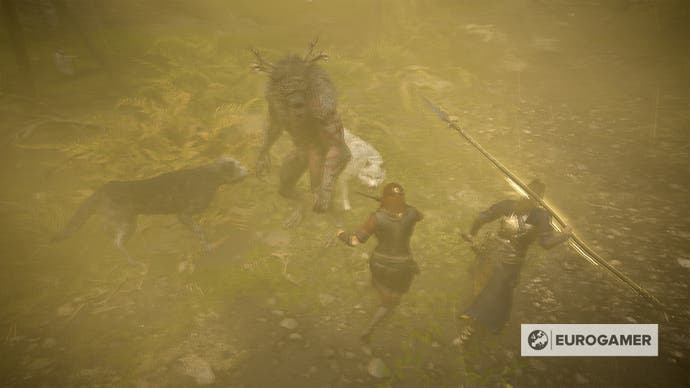
Do you want another 15 hours of solid Assassin's Creed Valhalla? More than 100 hours in, I spent the weekend tearing through Wrath of the Druids and had a good time. My Eivor is even more powerful, the story and its various side-quests and epilogues were entertaining, and I have a bunch more beautiful countryside to comb for trinkets and puzzles in the future. And I now know some accurate Irish history too, I think.



